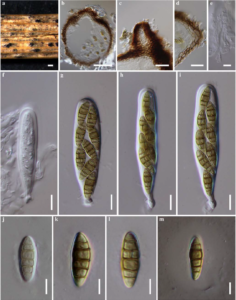Allophaeosphaeria dactylidis Wanasinghe, Camporesi, E.B.G. Jones & K.D. Hyde.
Index Fungorum Number: IF550894, Facesoffungi Number: FoF 00384; Fig. 1
Etymology – Named after the host genus from which it was collected, Dactylis.
Holotype – MFLU 14–0754
Saprobic on dead herbaceous branches. Sexual morph Ascomata 100 – 150 μm high 100 – 175 μm diam. (x̄ = 142.2 × 131.2 μm, n = 10), solitary, scattered, immersed to erumpent, globose or subglobose, dark brown to black, coriaceous, ostiolate. Ostiole 30 – 70 μm high 20 – 30 μm diam. (x̄ = 48.7 × 23.8 μm, n = 10), blackish-brown, smooth, ostiolar canal filled with dark brown cells. Peridium 10 – 15 μm wide at the base, 8 – 12 μm wide at the sides, composed with reddish to dark brown cells of textura angularis. Hamathecium comprising numerous, 1.5 – 2.5 μm (n = 30) wide, filamentous, branched septate, pseudoparaphyses. Asci 60 – 90 × 10 – 20 μm (x̄ = 69 × 14.6 μm, n = 40), 8 – spored, bitunicate, fissitunicate, cylindricclavate to clavate, pedicellate, thick-walled at the apex, with minute ocular chamber. Ascospores 15 – 20 × 5 – 8 μm (x̄ = 18.2 × 6.3 μm, n = 50), overlapping 1 – 2 – seriate, ellipsoidal to subfusiform, upper part wider than the lower part, muriform, 3 – 5 transversely septate, with 1–3 vertical septa, constricted at the central septum, initially hyaline, becoming yellowishbrown at maturity, ends remaining lighter and cone-shaped, with rounded ends, without a mucilaginous sheath. Asexual morph Undetermined.
Material examined – ITALY, Province of Forlì-Cesena [FC], Corniolo, dead upright stems of Dactylis glomerata (Poaceae), 12 July 2013, E. Camporesi (MFLU 14–0754, holotype); ex-type living culture, MFLUCC 13–0618. GenBank ITS: KP744432; LSU: KP744473; SSU:KP753946.
Notes – Allophaeosphaeria dactylidis is the second species of Allophaeosphaeria and it has muriform ascospores similar to those characterized in P. vagans (Niessl) O.E. Erikss., P. phragmiticola Leuchtm and P. phragmitis (Hollós) Leuchtm (Shoemaker and Babcock 1989). Multi-gene phylogenetic analyses (ITS, LSU and SSU sequences) indicated that Allophaeosphaeria dactylidis belongs to Phaeosphaeriaceae, but is distinct from Phaeosphaeria sensu stricto.

Fig. 1 Allophaeosphaeria dactylidis (holotype). a Ascomata on host substrate b Section of ascoma c Close up of ostiole d Peridium e Pseudoparaphyses f–i Asci j–l Ascospores m Ascospores stained in Indian ink. Scale bars: a = 200 μm, b = 50 μm, c, d = 20 μm, e – i = 10 μm, j – m = 5 μm.
